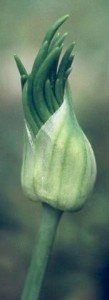Wild Onions
by Valerie (November 13, 2002)
 In one small section of a garden, I've planted numerous tiny bulbs of the two principal types of wild onion that grow around here. As they both spread readily, there is now a nice little two square feet of onion "grass" that predominates.
In one small section of a garden, I've planted numerous tiny bulbs of the two principal types of wild onion that grow around here. As they both spread readily, there is now a nice little two square feet of onion "grass" that predominates.
The plant with the most attractive flowers is often called wild garlic (Allium drummondii) or Drummond wild onion. The flowers are pink and appear in the early part of the growing season. After a lengthy bloom period, the foliage wilts and the bulbs go dormant throughout the hottest part of the summer. Wild garlic can be found in very dry, open areas, as well as wetter places, and seems to do okay even in the shade.
The other wild onion (Allium canadense) is a bit bigger and has a much different method of blossoming. Instead of flowers, it often produces little bulbs on top of the "flowering" stems. Some plants have a few white flowers mixed in with the bulbs and some just produce a bouquet of tiny bulbs. Sometimes the bulbs are even beginning to sprout before they fall to the ground. Of course, this method of reproduction is much more efficient than going through all the trouble of flowering first, so we are gradually getting more and more of this latter species in the mix. While the foliage of both plants dies back in the summer, it sprouts again in the autumn, growing all through the winter. Like other bulbs, vetches, and numerous other flowers, these plants prefer the cooler season. The wild onions have delectably aromatic foliage and can be used like regular onions for seasoning food. It is not an overpowering onion smell, but has a tinge of sweetness. When using the edger around the onion patch, the smell is enough to make my mouth water. |
